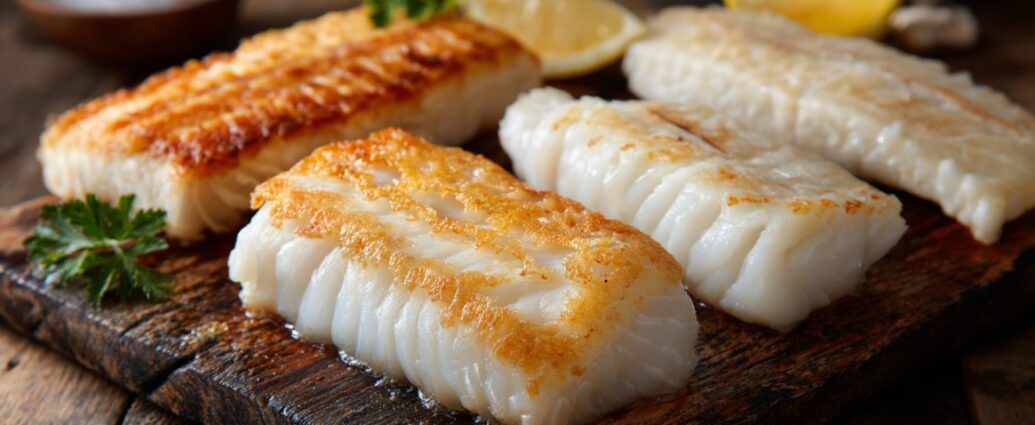Fried white fish dishes like fish and chips have been loved for generations. Choosing the right type of fish plays a major role in flavor, texture, and cooking performance.
Cod, haddock, and pollock often take the spotlight, each offering something distinct when dropped into hot oil.
Deciding between them depends on taste preference, budget, and even sustainability.
| Feature | Cod | Haddock | Pollock |
|---|---|---|---|
| Flavor | Mild, slightly sweet | Slightly sweet, richer | Stronger, savory |
| Texture | Flaky, delicate | Firm, flaky | Firm, juicy |
| Best Frying Use | Traditional fish & chips | Chefs’ favorite batter | Fish sticks, tacos |
| Sustainability | Farmed/Alaskan | Widely available | Alaskan = excellent |
| Cost | Moderate | Moderate to high | Most affordable |
Cod

Cod maintains a reputation as one of the most reliable choices for frying, cherished for generations across different cuisines.
Its mildness makes it accessible to nearly every palate, while its tender flakes deliver comfort with every bite. For many people, cod is their first positive encounter with seafood, thanks to its clean taste and subtle sweetness.
That neutrality makes it versatile in both simple home kitchens and professional restaurants.
When cooked properly, cod develops a moist interior that contrasts with a crisp, golden crust. A bite of fried cod practically melts in the mouth, offering just enough flavor without overpowering the batter or sides.
Care must be taken during frying, though, because cod is delicate and loses moisture quickly if exposed to high heat for too long.
Once overcooked, it becomes dry and rubbery, which is why temperature control and timing are key.
Cod is most often linked with the world-famous fish and chips. Paired with salt, malt vinegar, or lemon juice, it shines by acting as a base for other flavors. Its adaptability also makes it work with creamy tartar sauce, garlic aioli, or even spicy condiments.
That quality explains why cod has been embraced internationally, fitting into countless regional variations of fried fish dishes.
@kidderikSo, this was my very first time frying 🐟 Cod fish 😅…how did I do? 👀♬ original sound – Erik Hopkins
- Pros: Mild taste that pleases most people, works with any sauce, adaptable in recipes, flaky and moist when cooked well
- Cons: Can be bland for those who like stronger flavors, easily dries out if overcooked
Sustainability plays an important role in choosing cod. Opting for farmed Atlantic cod or wild-caught Alaskan cod helps reduce environmental impact while ensuring a steady supply.
With careful sourcing and cooking attention, cod continues to hold its crown as a classic for frying.
Haddock

Haddock enjoys a strong reputation among chefs who appreciate its slightly firmer flesh and more defined flavor profile. While it shares similarities with cod, haddock brings more character, carrying a subtle sweetness alongside a savory depth.
This quality makes it particularly effective in dishes where stronger batters or sauces are used, since it does not fade into the background.
In British fish and chip shops, haddock is often preferred over cod. Its structure allows it to remain intact during frying, even when coated in thick, heavy batter.
That resilience is what makes it so popular among professionals who need consistency in large-scale frying operations.
The firmer flakes hold together, giving each bite substance while still offering tenderness.
Haddock pairs wonderfully with butter-based batters, which highlight its natural richness. It also complements curry sauces or spiced seasonings, offering balance without becoming overwhelming.
Many home cooks enjoy haddock for its ability to satisfy those who want more flavor than cod without moving into strong or “fishy” territory.
View this post on Instagram
- Pros: Balanced flavor with a touch of sweetness, firm enough to hold up in frying, works well with bold sauces, and versatile in preparation
- Cons: Not as flaky as cod, which may reduce its appeal for those who love delicate textures
From a sustainability perspective, haddock offers reassurance since it is widely available in responsibly managed fisheries.
That accessibility makes it a practical and environmentally responsible option both at restaurants and in home kitchens.
Pollock

Pollock often remains in the shadows of cod and haddock, yet it delivers outstanding qualities for frying when given proper attention. Its texture is firmer and juicier than cod, which allows it to hold up well under high heat.
Unlike some delicate species, pollock resists falling apart, making it an excellent candidate for frying in a variety of styles.
Flavor sets pollock apart. Compared to cod or haddock, pollock carries a more pronounced taste that appeals to those who enjoy seafood with character. While that strength may not suit everyone, it makes pollock an excellent partner for bold seasonings and hearty batters.
Chili-spiced coatings, garlic-infused sauces, or tangy marinades all work well with pollock, showcasing its ability to handle intensity.
Many commercial food products rely on pollock, such as fish sticks, fish sandwiches, and tacos. Its adaptability and affordability have made it one of the most widely used white fish in the industry.
At home, pollock can provide a more flavorful alternative to cod while remaining budget-friendly.
@blackrose909_ Fried pollock fish. #soulfoodcooking #friedfish #blackrose909_ #fyp #blacktiktokcommunity #cookwithme #easyrecipes #cookingtiktok #seafoodlover #fishfry ♬ U Know What’s Up – Donell Jones
- Pros: Juicy and firm texture, high in omega-3 fatty acids, low in fat, cost-effective, reliable for frying in different preparations
- Cons: Flavor can be too strong for those who prefer mild fish, less popular in household cooking compared to cod or haddock
Pollock also earns praise for sustainability. Alaskan pollock in particular is considered one of the most responsibly managed fisheries worldwide.
Choosing pollock not only provides great taste and value but also supports eco-conscious consumption.
What Makes a White Fish Good for Frying?
Choosing the right white fish for frying requires attention to several qualities that directly influence the outcome. Texture plays a central role because a fillet needs to flake apart while still holding its structure. A delicate yet firm bite ensures the batter or breading clings without slipping away in the hot oil.
When the texture is right, every piece delivers both crunch and tenderness in one bite.
Taste also matters. Some prefer a mild flavor that lets the batter or sauce do the heavy lifting, while others want a slightly stronger profile that contributes its character. Flavor intensity often guides which fish pairs best with different seasonings, spices, and cooking methods.
Moisture retention under high heat is equally important. Fish that loses too much water during frying becomes tough and dry.
Compatibility with batter or breading determines how versatile the fish will be. A light flour dusting might suit one type, while another works better under a hearty beer batter. Nutrition and sustainability also enter the equation.
- High omega-3 levels
- Lower fat
- Low mercury content
Environmentally aware choices point toward fish that come from responsibly managed sources.

- Flaky yet firm texture
- Mild to moderately bold flavor
- Strong moisture retention under heat
- Compatibility with different batters or breadings
- Nutritional value and sustainability
The Verdict
Haddock emerges as the best all-around choice, striking the right balance between flavor and texture while performing consistently under high heat.
Cod works best for beginners thanks to its mild taste, adaptability, and broad appeal. Pollock brings the boldest flavor, offering nutrition and sustainability benefits that make it perfect for adventurous cooks.
No single white fish option can be crowned the ultimate winner for everyone, but matching personal preference with cooking style makes each of these fish an excellent choice for the frying pan.



